President's Message
This has been the most amazing year! I had the distinct honor of two experiences especially related to the history of Henrico County. Descendants of Captain Thomas Harris gathered to lay a wreath at the location of their ancestral home which is now known as Curles Neck in the Varina District of Henrico County. Thomas Harris came to America in 1611 aboard the ship "Prosperous" with Sir Thomas Dale. He, no doubt, participated in establishing the settlement of Henricus, named for Henry, Prince of Wales, eldest son of King James I of England. Thomas Harris served in the militia and was promoted to Captain during the Indian uprising of 1622. He served in the House of Burgesses in 1623, 1624 and 1647. His land ownership was in excess of 2,500 acres.
The other experience was a visit to London where the story of what would later become Henrico began. My journey was only measured by hours. I could hardly imagine the long journey early settlers endured, as they traveled by ship to uncharted territory./p>
While in London I had the distinct feeling that I was walking in the steps of our ancestors. I was somewhat surprised at the information on Prince Henry that was available. As the eldest son of James I, Prince Henry was the heir apparent, but he died at the age of 18, it is thought, from typhoid fever. His brother Charles I became the next King of England, but that's another story.
Prince Henry was very accomplished for one so young and was much beloved. He was a patron of the arts and was especially interested in the colonization of America by the English. Devoutly religious in the Protestant faith, Prince Henry was made aware that the native Indians had never even exposed to Christianity. Robert Tindall, who was a member of the first expedition to ""New Virginia," wrote to the then 13-year-old prince from James Towne as early as June of 1607. Tindall later charted the York and James Rivers in 1608. Prince Henry was also responsible for the assignment of Sir Thomas Dale to the colony in Virginia. Upon Prince Henry's death in 112, all of England was grief stricken.
In 2012 the National Portrait Gallery in London marked the 400th anniversary of the Prince's death with an exhibit titled "The Lost Prince: The Life and Death of Henry Stuart." A suit of armor made for Prince Henry is on display at the Tower of London.
Meanwhile the story continues. Pocahontas (whose Christian name was Rebecca) traveled to England with her husband, John Rolfe, and son, Thomas. She visited with Captain John Smith wile there, unaware before her arrival that he was still alive. She became ill and died shortly after departing from London on her way home but while still in England. She is buried in Gravesend, Kent at St. Georges Church. Her son, Thomas Rolfe, later returned to American
After the Indian uprisings of 1622 and 1644, an attempt was made to protect and recolonize the territory. Land on which a fort was constructed was exempt from taxes for three years. Existing forts and all property would be given to anyone who would maintain them. Fort James was under the command of Lieutenant Thomas Rolfe, and Fort Charles was under the command of none other than our Captain Thomas Harris. It was thus the history of Henrico County began.
Along a lighter note, we are very pleased to announce the first fundraising event for the Meadow Farm kitchen project was a success, thanks to the generosity of the Colonial Dance Club of Richmond, Lurline and Allan Wagner, our volunteers and all of you who attended. We would also like to thank those who could not attend but sent a donation for the project that will interpret another era in Henrico history.
The next scheduled fundraising event for the Meadow Farm kitchen project will be held January 11, 214, at Dorey Park Recreation Center in partnership with the 12th Virginia Infantry re-enactor and living history interpreters. There will be 1860's dancing (period attire optional) silent and live auctions and other activities. Registration is required. Additional information is included in this issue. You can also register on the HCHS website at www.henricohistoricalsociety.org/shopping.html. We hope to see you there.
May you and your family have a wonderful holiday and may we all have another exciting New Year!
Sarah Pace
President
>Back to Top<
It's Dues Renewal Time
One year membership dues are as follows:
- Individual $15.00
- Family $20.00
- Student or Child $5.00
- Supporting $25.00
- Sustaining $50.00
- Corporate $100.00
- Benefactor $300.00
- Lifetime $500.00
Make checks payable to:
Henrico County Historical Society
P.O. Box 90775
Henrico, VA 23273-0075
or purchase online at www.henricohistoricalsociety.org/membership.payment.html.
Memberships make a great holiday gift! Be sure to include the name and address of the recipient. They will receive a copy of our newsletter four times a year.
>Back to Top<
Members Take September Tour of Henricus Historical Park
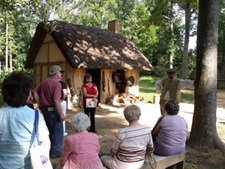
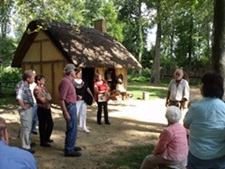
Historical interpreters help recreate the settler and Native American experience for HCHS members at Henricus, the second successful English settlement in the New World. The park is in what is now Chesterfield County, one of the ten counties carved completely or in part of Henrico, one of the five original shires. Photos supplied by John Shuck.
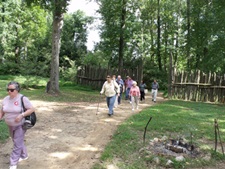
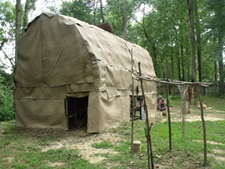
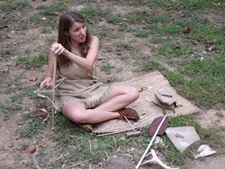
>Back to Top<
Tea for Two Groups
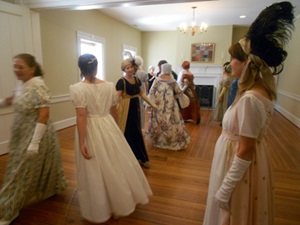
On Sunday, September 29, the Henrico Historical Society and The Colonial Dance Society of Richmond took over Walkerton Tavern for an afternoon of fine tea, gourmet delicacies and dancing - a culturally uplifting fundraiser. Tea afficianado and pastry chef Lurline Wagner provided the refreshments and provided this overview of tea.
Tea History
Tea consumption increased dramatically during the early nineteenth century and it is around this time that Anna, the 7th Duchess of Bedford is said to have complained of "having that sinking feeling" during the late afternoon. At the time it was usual for people to take only two main meals a day, breakfast and dinner at around 8 o'clock in the evening. The solution for the Duchess was a pot of tea and a light snack, taken privately in her boudoir during the afternoon.
Later, friends were invited to join her in her rooms at Woburn Abbey, and this summer practice provided so popular that the Duchess continued it when she returned to London, sending cards to her friends asking them to join her for "tea and a walking the fields." Other social hostesses quickly picked up on the idea, and the practice became respectable enough to move it into the drawing room. Before long, all of fashionable society took Afternoon Tea. This tea-related ritual, introduced in Britain in the early 1840s, evolved into a mini meal to stem midday hunger in anticipation of an evening meal at 8pm.
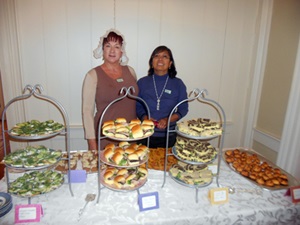
Afternoon Tea
Afternoon Tea is a meal composed of sandwiches (usually cut delicately into "fingers"), scones with clotted cram and jam, sweet pastries and cakes. Interestingly, scones were not a common feature of early Afternoon Tea and were only introduced in the twentieth century.
Afternoon Tea was initially developed as a private social event for ladies who climbed the echelons of society. It was only when Queen Victoria engaged in the Afternoon Tea ritual that it became a formal occasion on a larger scale, known as "tea receptions."
These receptions could have as many as two hundred guests with an open "at home" invitation to visit between 4pm and 7pm, during which they could come and go as they pleased; this was the genesis of the Afternoon Tea as we know it.
In Britain and USA today Afternoon Tea is usually enjoyed as an occasional indulgence or to celebrate a special event such as a birthday, or a pre-wedding or baby shower party with a group of friends.
A Recipe from the Celebration
Colonial Apple Cake
Ingredients
- 2 and 3/4 cups unsifted all-purpose flour
- 1 tsp baking powder
- 1 tsp ground cinnamon
- 3/4 tsp salt
- 1/2 tsp baking soda
- 1 and 3/4 granulated sugar
- 1 and 1/4 cups Crisco oil
- 2 eggs
- 1/4 cup milk
- 1 tsp vanilla
- 2 cups chopped, peeled apple
- 1 tsp grated lemon peel
- 1 to 2 tbsps confectioner's sugar
Directions
- Preheat oven to 350 degrees. Grease and flour 12-cup fluted ring pan. Set aside.
- Mix flour, baking powder, cinnamon, salt, and baking soda in medium mixing bowl. Set aside. Combine granulated sugar, Crisco oil, eggs, milk and vanilla in large mixing bowl. Beat with electric mixer at medium speed until blended, scraping bowl constantly. Add dry ingredients. Beat at medium speed 2 minutes longer, scraping bowl frequently. Stir in apple, and lemon peel. Pour into prepared pan.
- Bake at 350 degrees, 1 hour to 1 hour and 15 minutes, or until wooden pick inserted in center comes out clean. Let stand 10 minutes. Invert onto serving plate. Cool slightly. Sift confectioner's sugar onto cake. Serve warm.
>Back to Top<
Twelfth Night Gala
Help raise funds for the Meadow Farm kitchen at 12th Virginia Infantry's Twelfth Gala Night!
It will be held at the Dorey Park Recreation Center on Saturday, January 11th from 7:00pm to 11:00pm.
Music will be provided by String-Tyme Minstrels.
There will be a silent auction of books, jewelry, etc. There will be a live auction of P. Buckley Moss print.
A gift will be provided for every pre-registered lady in attendance.
To register, please see www.henricohistoricalsociety.org/shopping.html. Registration can be made online or by mail.
All pre-registered attendees will be entered into a dawing. You must be present to win.
>Back to Top<
Getting Out the Word About the Cemetery Clean-up
On December 5, John Shuck spoke to the Fan Women's Club about the work he has been doing at Evergreen and East End Cemeteries. He also made a presentation on teh history of the cemeteries and the history of the clean up effort.
>Back to Top<
Museum of the Confederacy Announces Partnership
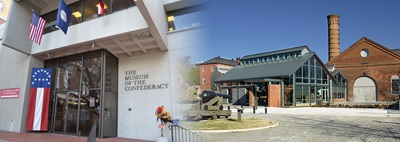
In a letter to the members of the Museum of the Confederacy, President and CEO of the institution announced the following:
For 123 years, the Confederate Memorial Literary Society has assembled, protected, and interpreted the most important collection of artifacts pertaining to the Confederacy in the world. In the 1890s, the CMLS reached out to the aging veterans and their families, humbly asking them to share their artifacts, and during the 1980s, the White House of the Confederacy was restored to the splendor enjoyed by Jefferson Davis and his family. In the 1990s we began a series of groundbreaking exhibits, and we opened our second site at Appomattox last year. Now, the CMLS is taking the next step in our long history of education and preservation.
The largest priority of the Museum of the Confederacy has always been the protection of its incredible collection. Artifacts like those that belonged to Stonewall Jackson, J.E.B. Stuart, Robert E. Lee, and many others need to be properly preserved for generations to come. However, the MOC building in Richmond is nearly 40 years old, and the Confederate Memorial Literary Society must take bold steps to ensure the safety of these artifacts. Space is needed to expand and add interactive components to their display and to give visitors better accessibility to living history demonstrations.
This morning, we announced that the Museum of the Confederacy is joining forces with the American Civil War Center at Historic Tredegar to make Richmond the "foremost Civil War destination in the United States." The $30 million project, of which $20 million has been committed, will result in the construction of a brand new museum building at the Historic Tredegar Iron Works site. This undertaking will put the whole institution on a much firmer financial foundation. The project will span 4-5 years, and the current museum in Richmond will remain open to the public until the new galleries are ready.
The new museum will provide better storage for the collection, improved displays, and a larger and better venue for hosting educational programs. At the same time, the White House of the Confederacy will be enhanced with new exhibits in time for its 200th birthday in 2018. The White House will continue to operate as normal, as will the Museum of the Confederacy-Appomattox.
We have retained Edelman Berland, an independent market research firm, to conduct a brief survey of our members and visitors to help us better understand how we can meet your needs. Our goal is to gather feedback that we can use to continually improve our exhibits, programs, and activities. Look for an email invitation in the next week. The survey should take no more than 10 minutes to complete, and your responses will be kept confidential.
This is an exciting time for the Museum of the Confederacy and the American Civil War Center. We rely on your support to help us see this project through. Caring for the collection is our biggest concerns. This new venture will ensure that the artifacts of the Confederacy are available for future generations just as they have been since 1890.
I am your most obedient servant,
S. Waite Rawls III
>Back to Top<
Browneville: A Dream Deferred - Plans from The Grand Fountain of United True Reformers
Sources:
- Bulletin of the Department of Labor, No. 389, January 1902.
- Burrell, W.P.G. & D. E. Johnson. Twenty-five Years History of the Grand Fountain of the United True Reformers.
- Harris, Abram Lincoln. The Negro as Capitalist.
- Manarin, Louis H & Charles H. Peple. The History of Henrico County.

Some communities grow, and some communities die. A cruise down Cary Street Road today takes us past a community that was only a dream. It was all the part of an idealistic vision of William Washington Browne, an ex-slave from Georgia, Methodist minister, and Grand Worthy Master of the Grand Fountain of the United Order of True Reformers.
While Browne did not found the order, he transformed it into a mutual benefit association and broadened the organization's membership by traveling throughout the South building smaller chapters, or sub-fountains. According to Twenty-five Years History of the Grand Fountain of the United Order of True Reformers, "The names of our societies are Fountains. A fountain is always running; it sends forth its waters, pure and clear at all times. A fountain cleanses itself, but a pond becomes stale and stagnant, and has to be ditched off or it will make everyone sick who lives near or by it." Through the fountains, Browne hoped to "stop playing, trifling and wasting our time and talents, and scattering our little mites to the four winds of the earth, and let us unite ourselves in a solid band."
Under Browne's direction, the Reformers established the first black-owned and operated bank, a hotel and other ventures. But our real concern here is the community his organization envisioned for Westham farm, the site of the historic Westham furnace then approximately six miles outside Richmond and then in Henrico County on the north side of Cary Street Road. In 1897, the fraternal organization bought the 634 1/4 acres for $14,400. A Bulletin of the Department of Labor indicates that the land contained "a large dwelling house, with the usual outhouses." On that land, The Grand Fountain planned to effect its 1893 decision "for the erection of Old Folks' Homes, for the benefit of the old people of the entire race regardless of society or denomination."
Unfortunately, in December 1897, Browne died of cancer that started in his arm, but his plan lived long after him. It was a cause that provided numerous and far-flung fundraisers, an example of which the May 17, 1906 New York Age reported, "On Monday evening, May 21, at Holy Trinity Baptist Church, 382 Classon Avenue, the Brooklyn Division of the Grand Fountain, United Order of True Reformers will hold a financial rally in the interest of the Old Folks' Home, a branch of the order located at Westham Farm, not far from Richmond, VA, where the old and decrepit members of the race may be cared for whether they are members of the order or not." And three years later, funds were still being solicited. The July 31, 1909 edition of Baltimore's Afro-American Ledger described: "children . . . dressed in white and wearing red, white, and blue regalia . . . [heard] the parable of the lilies . . . and then the children brought forward their contributions for the Old Folks' Home, which amounted to $14."
Additionally, plans later called for subdividing part of the land into 130 half-acre plots to be sold to African Americans, forming a community called Browneville in memory of the man instrumental in acquiring the property. The proposal seems to engendered great hope, anticipation, and unfortunately, great exaggeration. One officer claimed: "Notwithstanding the gloom of darkness . . . those of faith rallied to the flag, and many lots were sold . . . God sent men of means with an electric car line, terminating at the boundary of the farm . . . and doubly increased the value of the land . . . evidences of God's goodness and His acquiescence in the good work. This Negro settlement is destined to be the finest place of resort and pleasure of the Southland. It is called "Browneville," in honor of the founder of the Order. In 1902, every lot had been sold."
Sadly, none of these idealistic plans ever came to fruition, Louis Manarin notes in The History of Henrico County that "No lots were ever sold and no new buildings were built to house the elderly, but pictures of the then-existing farmhouse were used to promote the Old Folks' Home and in the solicitation of funds" While the Fountain's mutual benefit fund by 1901 did pay death benefits of $606,000 and sick benefits of $1,500,000 to members, Browne's bank eventually failed, ironically closing thirteen years after his passing on October 10, 1910, Browne's birthday.
Perhaps, had Browne lived on, his influence and apparent charisma might have made the home and community a reality. But those plans seem to have fallen prey to unethical management in the early part of the century, and the planned community that could have been a source of hope and a chance of upward mobility faded to a vague memory of promise.
>Back to Top<
Now You Know
Seeing the world in three dimensions - stereoscopes beat the blockbuster "Avatar" to it by a century and a half.
You might have had a View-Master as a child and marveled at the three-dimensional scenes on the little wheel of transparencies that you clicked through.
Well, nineteenth and early twentieth century children and adults had the same reaction when they peered through the lenses of stereoscopes and slid the wooden cross-piece to bring three dimensions to an otherwise flat pair of images.
HCHS member Haywood Wigglesworth correctly identified our last "What Do You Know?" item, and he wrote, "In my reprint of a Sears catalog the item in teh current newsletter is called a stereoscope. The one in the catalog seems to be identical to the one pictured, and as you probably know, could be had for 49 cents."
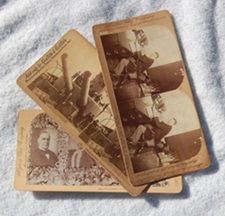
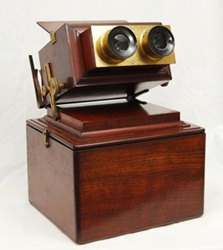
That 49-cent stereoscope would be loaded with a stereocard in the wire rack on the cross-piece. The card, as seen below right, held two images side-by-side, each taken at a slightly different angle. Political and military views like those shown were popular, as were travel pictures, religious scenes, comic situations, and many more.
As the user slid the image back and forth, it came into focus as the eyes combined the two images into a single one. Almost magically, the user saw in three dimensions.
While the stereoscope directly at the right was the most common type, other more elaborate viewers abounded. They included table-top models like those seen below, which featured fine woods, inlays, carvings, and even attached boxes for stereocard storage.
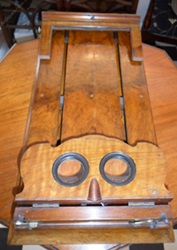
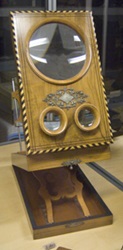
>Back to Top<
What Do You Know?
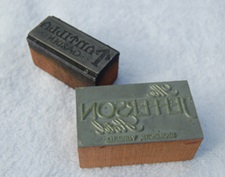
Both items pictured are 7/8 inch thick. The larger measures 2 x 1 1/8 inches. The smaller measures 1 3/4 x 3/4 inches. Both are made of wood and metal.
Do you know what they are? Email your answers to jboehling@verizon.net.
>Back to Top<
News 2013: Fourth Quarter
First Quarter | Second Quarter | Third Quarter
Home | Henrico | Maps | Genealogy | Preservation | Membership | Shopping | HCHS
|











